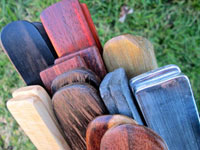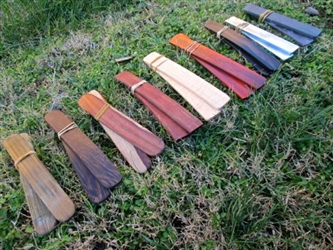Flat Style Bones
Flat bones are easy to grip and the wider styles enable you to produce an amazing tonal range. They're also excellent for women, kids, and players with small hands.
I love flat bones. They are among my top favorites. And if you like generating different tones, then you'll want to go for the wider styles. Want bones that are sure to fit your hands? Flat bones are relatively thin as a rule, and easy to grip no matter what size your hands are. Flat bones are perfect for my hands which are medium. Players with large hands will probably prefer the more robust styles. Got small hands? Then flat bones are especially well suited for you.
The Face is What's Flat
 The Face (i.e. striking surface) is flat. That's why they're called flat bones. If you cut a flat bone across the width and look at the profile, you will see the shape is rectangular. (Rather than chop up a bunch of perfectly good instruments, you can discern the rectangular shape in this end-view photo of flat bones, pictured right.) By comparison, Minstrel Style Bones are oval.
The Face (i.e. striking surface) is flat. That's why they're called flat bones. If you cut a flat bone across the width and look at the profile, you will see the shape is rectangular. (Rather than chop up a bunch of perfectly good instruments, you can discern the rectangular shape in this end-view photo of flat bones, pictured right.) By comparison, Minstrel Style Bones are oval.
Flat Bones Can—and Usually Do Sport a Standard Arc
The vast majority of flat style bones are curved. Flat bones with no curve are called plank bones. Plank bones are literally flat as a board. Examples of plank bones include Stone Bones (made from roofing slate) and Bot Bones (made from bars of aluminum). So all plank bones are flat bones. But only some flat bones are plank bones. You might think of flat bones as bent planks. (Aaron Plunkett Lignum Vitae Bones and Hans Weehuizen Bentwood Bones are literally bent planks.)
No matter what you call them, flat bones are a popular design and easy to play with any size hands.
Can't Decide Which Bones to Choose?
Check out this handy guide: Bone FAQs
|
|
|

